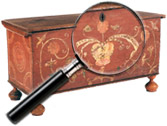|
|
Emile Galle (1846-1904)
Frenchman Emile Galle was one of the Continent’s most innovative leaders of the Art Nouveau Movement. His glass studio, established in 1874 at Nancy, revived the ancient form of art cameo engraving in multiple layers of glass. Galle is also noted for signing virtually all of his work, inspiring other, previously anonymous glass artisans to sign their work as well. The Galle studio closed in 1936. His influence continued through the [...] Click here to continue reading.
Jacques Lipchitz (French, American, 1891 to 1973)
Chaim Jacob Jacques Lipchitz was born in Lithuania but moved to Paris in 1909 to study at the Ecole des Beaux Arts and the Academie Julien. He immersed himself in the French artistic community, befriending fellow artists such as Alexander Archipenko, Pablo Picasso, and Amedeo Modigliani. Lipchitz soon established himself as one of the leading proponents of Cubist sculpture. By the early 1930s he had dramatically shifted [...] Click here to continue reading.
Tom McCandless (1924-2010) My Father’s New Hobby
Our father’s new hobby began to get our attention when, after a long day at work, he started disappearing into the basement in the evenings to scrub dirty old bottles. As three active boys we noticed even more when some of the cleaned up bottles started to appear upstairs and, for the ï¬rst time, we had to exercise some restraint and try not to bash into these [...] Click here to continue reading.
George E. Ohr, American Potter, 1857 to 1918)
Starting as a potter in New Orleans with his friend Joseph Meyer, George Ohr is often referred to as The Mad Potter of Biloxi, calling his creations “mud babies” and his shop the “Pot-Ohr-E”. The mud babies had incredibly thin, pinched, crimped and fluted and maniupled walls in an unlimited number of creative forms.
With his two-foot mustache Ohr was an attraction along the Gulf Coast, [...] Click here to continue reading.
Additional items accompanying the personal archive of Major Richard Kidder Meade, Jr., CSA, (Brunk Auctions, sale of 16 July 2011, lot 527).
Textiles:
- Hand-sewn brown satin weave silk drawstring bag lined with maroon silk, embroidered with the first national flag of the Confederacy (“Stars and Bars”, 13 stars) and the second national flag of the Confederacy (“the Stainless Banner”) and the motto Pro Aris et Focis – literally “for our altars and our [...] Click here to continue reading.
Hanga, or Japanese Woodblock Prints
In Japanese, woodblock prints are called hanga; han means ‘a printing block’, and ga is ‘picture’. The colorful and varied tradition of Japanese woodblock printmaking includes 17th to 19th century ‘ukiyo-e’ (the celebrated “Pictures of the Floating World”), 20th century ‘Shin hanga’ (“New Prints”) and ‘Sa ‘ saku hanga’ (“Creative Prints”) works, and Modern/Contemporary prints.
Ukiyo-e were pictures of exciting people and scenes from the entertainment districts of old [...] Click here to continue reading.
William Lipton: Dealer, Scholar, Collector
William Lipton’s first journey to Asia occurred in the early 1970′s. He was immediately seduced by the culture of the East, and arranged for a return the following year with Jim Thompson at the Thai Silk Company, where he remained for six years, ultimately as the director of design. During this period he traveled extensively throughout Asia, often accompanied and advised by the Hong Kong dealer Charlotte Horstmann.
“I [...] Click here to continue reading.
Virginia Bare, 18 February 1925 to 11 June 2011
Virginia Bare considered red her signature color. After all, red is the color of love, and Virginia loved deeply: her family, her friends, her antiques, and her houses. Over 50 years, Virginia traveled throughout Ohio, Pennsylvania and New England, often with her dear friend Sam Forsythe or beloved daughter Julie, seeking old and beautiful objects to sell in her shop or enjoy in her home. [...] Click here to continue reading.
Flag Act of 1777
The first national flag of the United States, known as the Continental Colors, retained the Union Jack in the canton. The flag act of 1777 mandated that stars replace the British Union flag to which the act referred to as “a new constellation”. The act, however, failed to lay down a firm design as to how the stars should be arranged and manufacturers of “Old Glory” incorporated their own placement [...] Click here to continue reading.
American Windsor Chairs
Windsor chairs of the 18th and 19th Century are often depicted in American folk paintings of the same period. They are colorful, plentiful, and come in many styles. Carved mahogany Chippendale furniture of this period and later the more elegant inlaid Federal furniture was for only the very wealthiest consumers; however, Windsor furniture was available to the middle and lower classes because it was relatively inexpensive. The best antique Windsor furniture [...] Click here to continue reading.
|
Recent Articles
- Charles Alfred Meurer – American Artist & Tromp L’Oeil Artist
- Sendak, Maurice – American Artist & Writer
- Godie, Lee – American Artist
- Davis, Vestie – American Artist
- Bartlett, Morton – American Artist
- Mackintosh, Dwight – American Artist
- Evans, Minnie Jones – African-American Artist
- Mumma, Ed (Mr. Eddy) – American Artist
- Nice, Don – American Artist
- Savitsky, John (Jack) – American Artist
- Gordon, Harold Theodore (Ted) – American Artist
- Dial, Thornton – African-American Artist
- Doyle Sam – American Artist
- Johnson, Lester Frederick – American Artist
- Finster, Howard – American Artist
|
|
